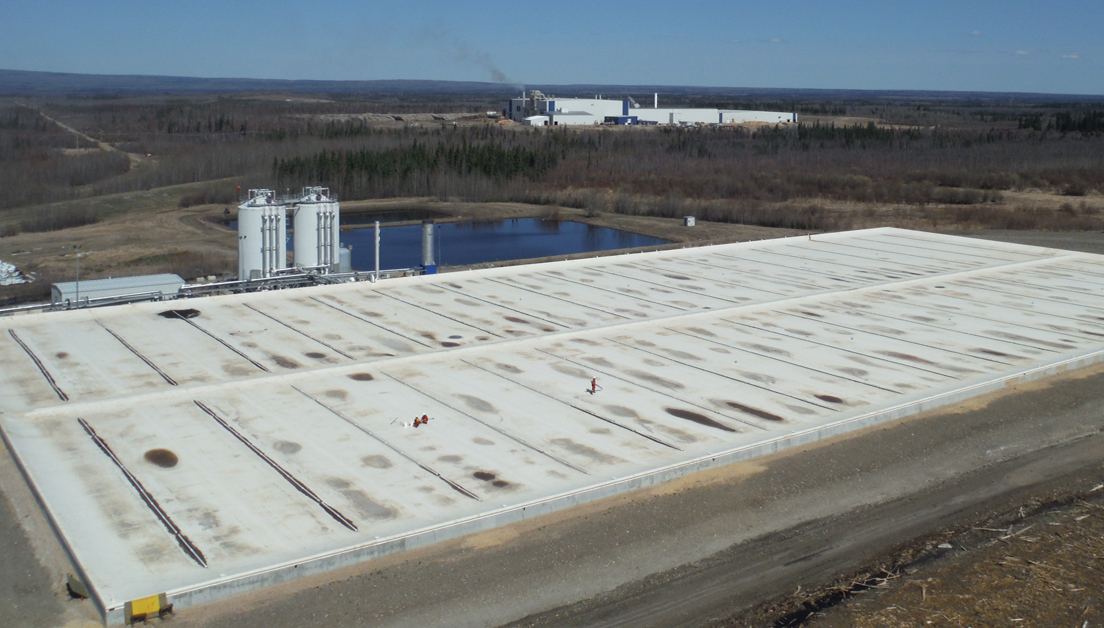Slave Lake Pulp, a subsidiary of West Fraser Mills Ltd., is a 240,000-tonne-per-year Bleached-Chemi-Thermo-Mechanical Pulp (BCTMP) mill located in northern Alberta, Canada. The mill primarily processes aspen to produce market pulp for the global market.
Challenge
Slave Lake Pulp generates a high-strength wastewater stream, which was previously being treated in an energy-intensive conventional activated sludge (CAS) system. The mill frequently alternates pulp brightness grades, resulting in fluctuations in the wastewater’s chemical oxygen demand (COD) concentrations from 5,000 to 19,000 mg/l. This meant that process stability and the ability to handle variations in hydraulic and organic loads were important factors when selecting an anaerobic digestion system.
The company decided to explore biomethane for power generation—both for its environmental and its cost-saving benefits. With assistance from the Climate Change and Emissions Management Corporation (CCEMC) and the Government of Alberta, Slave Lake Pulp embarked on a Biomethanation and Power Generation Project that would anaerobically digest pulp mill effluent to generate biogas to be used as green energy.
" We run very lean. We needed something that wasn’t going to be a big drain on our resources. "
Solution
Slave Lake Pulp chose ADI-BVF® technology for the project, and ADI Systems designed and installed a 120,000 m3 (4.2 million ft3) reactor for anaerobic effluent pre-treatment. The low-rate treatment system is believed to be the first in Canada for the pulp and paper sector.
The upgraded wastewater treatment system consistently achieves a high organic removal efficiency and biogas production rate, yet the technology is relatively simple and has few moving parts. The reactor was constructed as an earthen basin with a concrete perimeter wall lined with a geotextile underlay and geomembrane liner and insulated cover.
The Biomethanation and Power Generation Project also included ADI Systems installing a BioGasclean biological scrubber system to reduce the hydrogen sulfide (H2S) content in the biogas generated from the BVF® reactor. The BioGasclean system consists of two parallel 550 m3 (19,423 ft3) scrubbing tanks filled with packed media and Thiobacillus bacteria which biochemically convert the sulfide in the biogas to sulfate. They are among the world’s largest biological scrubbers installed in terms of hydrogen sulfide load treated.
Biogas generated in the system migrates to the reactor cover perimeter, where blowers pull gas through the biogas scrubbing system, boost the gas pressure, and transmit the scrubbed biogas to a set of three 3 MW gensets designed for biogas applications.

Results
The wastewater treatment system that ADI Systems designed and installed for Slave Lake Pulp is helping the mill improve consistency of final effluent quality. The BVF reactor can handle swings and peaks in hydraulic and organic loads, and digests over 85% of the BOD load anaerobically, with no aeration and minimal mixing.
Anaerobic pre-treatment has allowed Slave Lake Pulp to decommission one of the four existing aeration basins, simplifying the overall treatment system and reducing operating costs associated with traditional aerobic treatment systems. The system requires little operator attention and no granular sludge, and decreases sludge generation for the overall wastewater treatment system. Anaerobic digestion has also reduced chemical usage by 50-70% and significantly reduced costs for electrical and sludge disposal associated with biological wastewater treatment.
Biogas generated during anaerobic digestion has provided Slave Lake Pulp with a green energy source; 10.4 GJ of biogas energy is generated per tonne of COD anaerobically removed, resulting in up to 6 MW of electrical power generation through biogas scrubbing and utilization.
Slave Lake Pulp’s Biomethanation and Power Generation Project has greatly improved the mill’s long-term economic sustainability and its commitment to the environment.
